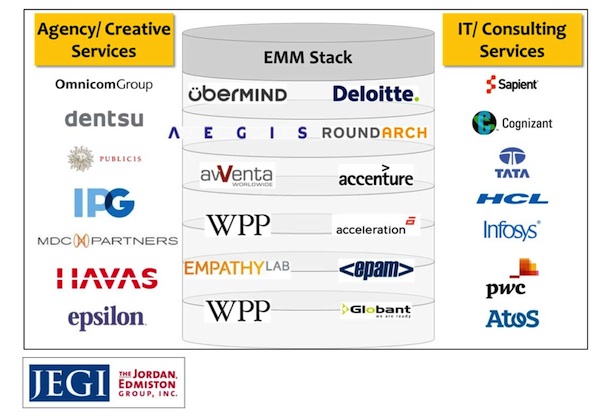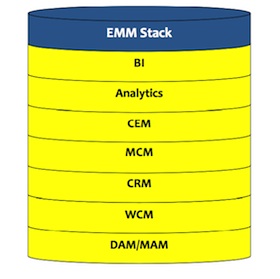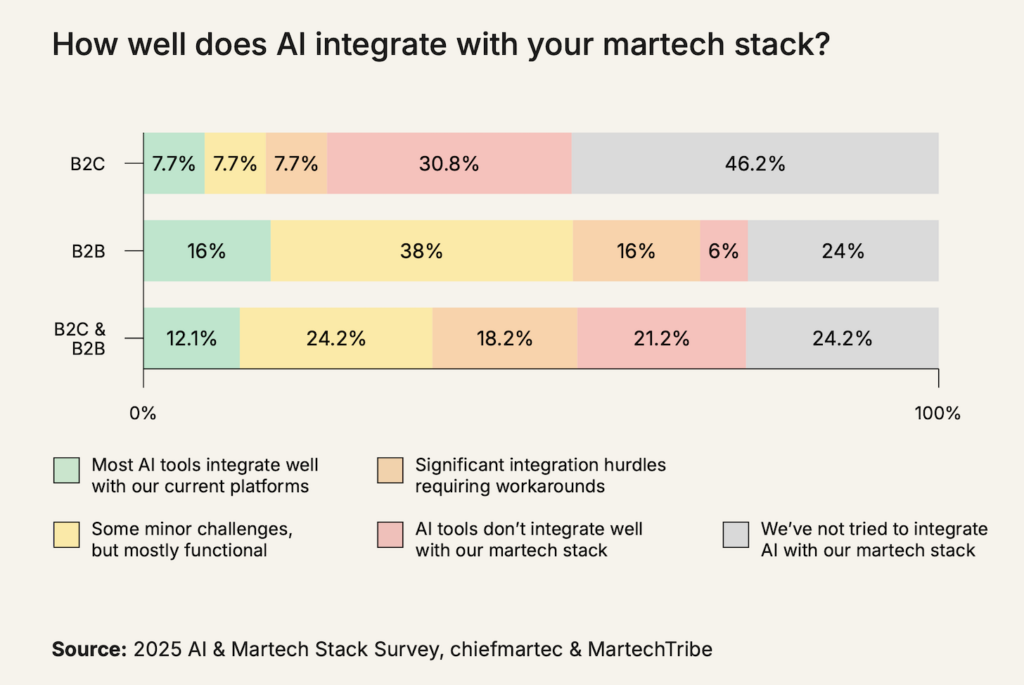The Jordan Edmiston Group, Inc. (JEGI), a leading investment bank in the marketing and media space, recently released a new report on the enterprise marketing management (EMM) stack. They start by noting that from 2010-2012, four companies (“The Big Four”) have invested over $20 billion in marketing technology M&A: Adobe, IBM, Oracle, and Salesforce.
But they quickly point out that some of the biggest disruption resulting from these acquisitions hasn’t been in the enterprise software space — it’s been in the marketing services space. “Their world has virtually turned upside down,” they note.
To make their point, they share two upside-down quotes from industry executives. First, this one:
“Despite all of this technology at work, the most critical element in our evolving service mix is world-class creative capabilities.”
Think that statement came from an agency? Nope. It was made by the CMO of a leading IT service firm. Here’s the other one:
“Our role is to serve as a systems integrator for our clients… to help brands tell their stories via marketing technologies and application programming interfaces (APIs).”
Sounds like a typical IT integrator, right? Nope. That statement came from the chief strategy officer of a global agency group.
It’s clear that agencies and IT/consulting services will be duking it out over the CMO’s increasingly technology-driven budget and attention. What’s interesting is that this strategic battle seems to be converging around the different layers of the EMM stack, as illustrated by JEGI’s graphic at the top of this post.
But lest you think that software vendors are safely above this fray, take a peek at companies such as Fabric, a “marketing operating system” that is backed by WPP and and has a strategic partnership Infosys. (Theirs should be the textbook definition of a “frenemy” relationship.) Or Code Worldwide, backed by Omnicom, that has been ranked by Gartner as a visionary in the marketing resource management (MRM) software space, competing with software providers such as SAP, Orbis, IBM, Aprimo, and MarcomCentral.
Or, in the other direction, consider that IBM and Oracle, two of the Big Four in enterprise marketing software, both generate a huge portion of their revenues from professional services.
The marketing technology frenemy triangle is heating up on all sides.
P.S. It’s also interesting to think of the major software players who are not yet very active in this enterprise marketing M&A frenzy. Strategic choice? Strategic oversight?
P.P.S. One quick update. Paul Roetzer of PR 20/20 alerted me to this great post on their blog: Will SaaS Companies Build Internal Marketing Agencies?





Great post, Scott. This is an incredibly important topic for marketing agencies. While some SaaS companies are publicly touting agency partner/affilate programs, the reality is that the agency ecosystem is slow to evolve, and can’t keep up with the rate of change. Thus, tech companies are being forced into the service business, whether they want to do it or not.
The challenge for the traditional agency world is that the tech companies don’t necessarily need to build services as a profit center, the services simply need to improve retention/reduce churn. So, if they choose, software companies could in theory undercut the market on pricing, and quickly gain market share from agencies.
It’s going to be a very interesting time as we move through the next 1-3 years (and beyond).
Completely agree! More and more we are learning how it is hard to stick with basic models that were the “traditional” ways of doing business. RFP’s without a discovery phase with a client to determine client’s needs are a prime example of this. As the markets are merging, changing new service opportunities and alternative sources of income become more readily accessible.
Hi,
Interesting article and agree with nearly all the comments. I should point out that Fabric Worldwide is backed by WPP only. Our relationship with Infosys is a strategic partnership but does not involve any investment (by Infosys) in our company and/or the Fabric OS.
Neil
Neil Miller
Joint CEO
Fabric Worldwide
Thanks for catching that, Neil! I updated the post accordingly.
Pingback: The Top 16 Marketing Automation Articles Curated Today, Friday, 2/15/13 « The Marketing Automation Alert
Hi. Great post, Scott. It prompted to meet to write a follow up piece on our blog http://www.marketingagencyinsider.com/blog/will-saas-companies-build-internal-marketing-agencies.
The premise is this. Strategy is the new battleground. Clients need help with the strategy of how to connect their messages as consumers move through increasingly complex journeys. And most of these connection points are on tech platforms, hence the strategy domain which once belonged to the agencies is now in play for tech vendors and consultants.
I love the piece about tech vendors getting more service orientated – and I think it offers an evolution model for agencies
Posted wrong link – apologies https://blog.codeworldwide.com/?p=1107
Ultimately, it feels like a “grass is always greener” scenario. Agencies want to be more like technologists. Technologists want to be more like agencies. Because neither are really happy with what they’ve got.
Scott – A great overview indeed. As an executive that has owned and operated medium sized agencies (i.e. $300M) in the past, we have will continue to see this convergence. And it is happening fast. A blend of strategy, management consulting, data analytic, technology and good old fashion creative thinking arms executives with a more holistic performance management platform.
I would like to comment that one of the key elements required is the analytic application of
Marketing ROI – and the “R” as defined through the lens of finance – measuring marketing contribution towards key indicators such as incremental cash flow, margin, acquisition, to name a few.
Many of the marketing automation and CRM systems fall short here, and typically get a company to a campaign level view of ROI. Some of this has to do with bi-lateral data or integration issues. But more fundamental is leveraging the proper MROI model to achieve a more enterprise view of marketing’s ROI. Absent of this, marketing will be still considered a cost, and not an investment.
Just thinking….
Pingback: The Agency vs Consultancy Collision | ExchangeWire.com
Pingback: addictive! the full service mobile agency